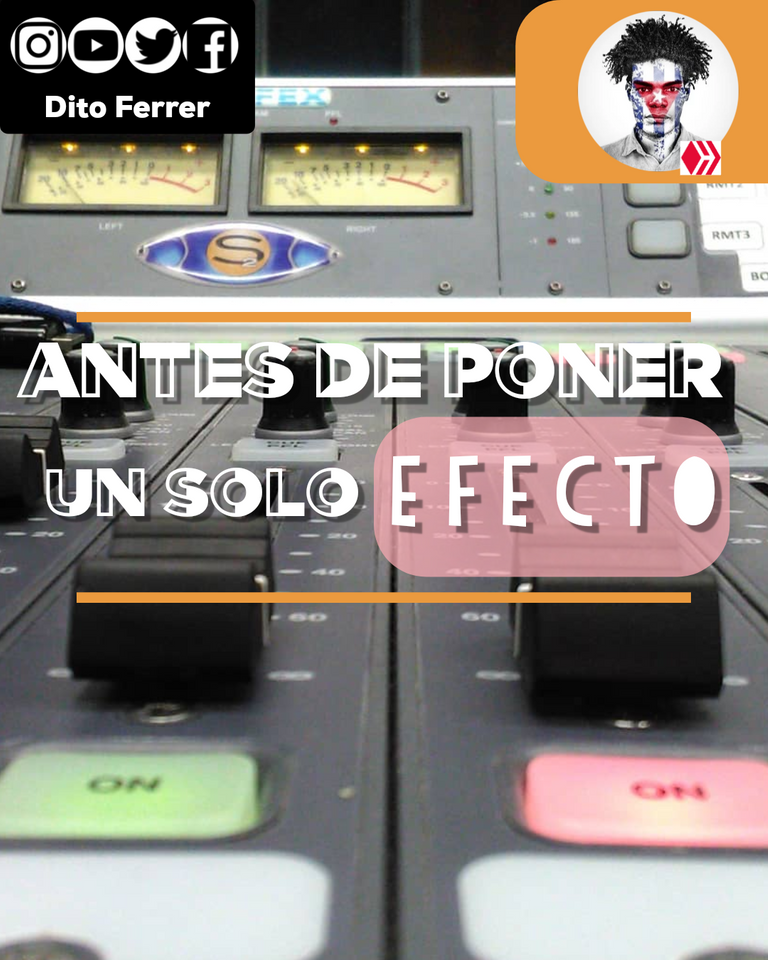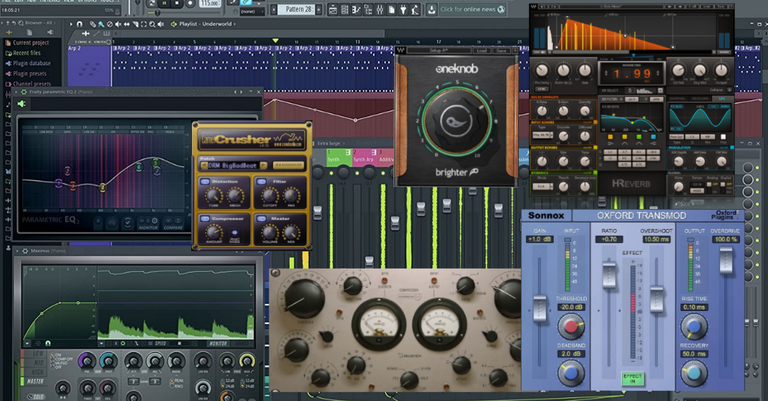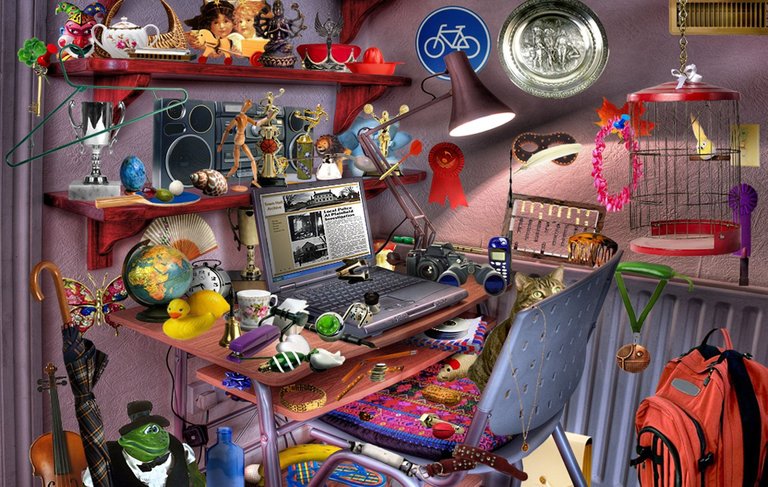
Un amigo vino a verme hace un tiempo para que lo ayudara a resolver un problema.
Se veía bastante mal, tenía los ojos enrojecidos por la falta de sueño, había olvidado afeitarse y tampoco olía a rosas. Traía su laptop bajo el brazo y la agarraba de un modo bastante sospechoso.
Lo invité a pasar y ni siquiera quiso sentarse. En cambio puso la laptop en mis piernas y me señaló el proyecto en el que trabajaba.
¡No quería ni tocar el teclado!
Me dijo que llevaba días intentando que "eso" sonara y estaba al borde de la locura.
Sentí pena por él y decidí echarle un vistazo. Me sorprendió la cantidad de efectos que tenía en su proyecto. Algo parecido a esto.

Imágenes tomadas de Pinterest y editadas con Over.
Pero se escuchada terrible. Los instrumentos chocaban entre sí, compitiendo por la misma frecuencia. No existía profundidad, todo parecía sonar "in your face". Para colmo, la voz principal se perdía cuando escuchabas la canción a un volumen bajo.
Hice la pregunta técnica que cualquiera hubiera hecho en mi lugar:
¿Qué m... hiciste aquí?
El intentó defenderse justificando el uso exacto de cada uno de los plugins que había puesto
Lo invité a sentarse, le ofrecí un café y me dispuse a explicarle.
El arte de la mezcla es la apropiada y creativa colocación y movimiento de las imágenes de sonido.
David Gibson. El Arte de la Mezcla.
Podemos hacer una analogía de este concepto imaginándonos nuestro propio cuarto. La mayoría de las personas, realmente no me puedo incluir en este grupo tiene su habitación ordenada; la cama bien tendida, nuestros libros de cabecera sobre la mesita de noche perfectamente ordenados, dentro del clóset las ropas en sus percheros y los zapatos colocados a un costado.
Así deberían estar dispuestos nuestros sonidos.
Pues más o menos así se veía la mezcla de mi amigo. Pero, afortunadamente, podemos hacer algo al respecto.
Y no es, precisamente, poniendo plugins como locos.
- Selección de sonidos:
Este es el primer elemento al que debemos prestar especial atención. Muchas veces añadimos a nuestro proyecto samples de librería que poco hacen por nuestro tema. Ya lo sé, a veces da pereza hacer scrolling por los cientos de sonidos de kick o presets en Sylenth y cargamos el primero que nos gusta, a sabiendas que los vamos a tener que trabajar intensamente para que se escuchen bien.
Deja de hacer esto.
Tómate tu tiempo buscando los mejores sonidos para tu canción. Tus oídos te lo agradecerán más adelante.
Recuerda que un sonido de calidad encuentra solo su lugar dentro de la mezcla. - Economiza:
Menos es más. A veces queremos que esa línea de bajo se escuche un poco más fuerte, así que apilamos unas cuantas capas más con diferentes plugins duplicando la melodía.
Cada sonido nuevo ocupa un lugar dentro del espectro de frecuencias y muy rápido se comen el espacio que debería quedar para otros instrumentos. Luego nos damos cuenta que suena muy cargado y allá vamos a poner efectos.
No lo hagas.
Revisa si cada instrumento realmente cumple una función dentro de la canción. - Revisa los planos sonoros:
No todos tienen que tener protagonismo, ni todo el tiempo. Seguro te has fijado, en los conciertos en vivo, como cada músico ocupa un lugar dentro del escenario.
Cada quien tiene su espacio y puedes verlos claramente. Esos lugares no están tallados en piedra, en ocasiones uno de ellos puede avanzar hasta proscenio para ejecutar un solo o moverse a lo largo del escenario. El resto de los músicos se reorganizará en consecuencia para permitirle a ese brillar.
Has lo mismo con tus pistas. Antes de poner un solo efecto decide el lugar que ocupará cada una dentro de tu escenario. Podrás moverlas luego si quieres. - Has espacio para tu instrumento principal (generalmente, la voz):
Resérvale ese lugar privilegiado desde el mismo principio, aunque no la tengas grabada todavía. Ayuda componer utilizando un analizador de espectros colocado en el máster. De esta manera puedes ir monitoreando los sonidos que puedan competir en el futuro con tu elemento principal.
Tan pronto la tengas grabada, colócala y sigue componiendo alrededor de ella, sin lugar a dudas te dejará en claro lo que no funciona.
A pesar de que recomiendo utilizar un analizador de espectros, la decisión final siempre la tomarán tus oídos. A veces la vista engaña.
Si sigues todos estos consejos vas a ahorrar tiempo, energía y motivación. A la hora de mezclar serás más intuitivo y ganarás confianza en ti mismo. Te sentirás orgulloso de mostrar tus proyectos a tus amigos.
Recuerda planificar tus sesiones en periodos de 45 min. a 1 hora.
Cuida tus oídos.
Tuve la suerte de que mi amigo entendiera toda esta explicación. Ahora, cada vez que visita mi casa, siempre tiene una gran sonrisa.
ENGLISH
A friend came to see me a while ago to help him solve a problem.
He looked pretty bad, his eyes were red from a lack of sleep, he had forgotten to shave and he didn't smell of roses either. He had the laptop under his arm and was holding it in a rather suspicious way.
I invited him in and he didn't even want to sit down. Instead put the laptop on my lap and pointed out the project he was working on.
He didn't even want to touch the keyboard!
He told me that he had been trying for days to make "it sound" and was on the verge of insanity.
I felt sorry for him and decided to take a look at it. It amazed me how many plugins he had on his project. Something like this.

Pictures from Pinterest and edited in Over.
But it sounded terrible. The instruments collided with each other, competing for the same frequency. There was no depth, everything seemed to sound "in your face". To top it off, the lead vocal disappear when you listened to the song at a low volume.
I asked the technical question that anyone would have asked in my situation:
What the f... did you do here?
He tried to defend himself by justifying the exact use of each of the plugins he had put on.
I invited him to sit down, offered him a coffee, and started to explain.
The art of mixing is the appropriate and creative placement and movement of sound images.
David Gibson. The Art of Mixing.
We can make an analogy of this concept by imagining our room. Most people (I really can't include myself in this group) have their room tidied; the bed is well made, our books on the bedside table are neatly arranged. In the closet, the clothes are on their racks and the shoes are on one side.
This is how our sounds should be arranged.

Source
Well, that's how my friend's mix looked like, more or less. But fortunately, we can do something about it.
And it is not, precisely, putting plugins like a mandman.
- Sound selection:
This is the first element to which we must pay special attention. Many times we add library samples to our project that do little for our song. I know, sometimes we get lazy scrolling through the hundreds of kick sounds or presets in Sylenth and we load the first one we like, knowing that we are going to work hard to make them sit in the mix later on.
Stop doing this.
Take your time looking for the best sounds for your song. Your ears will thank you later.
Remember that quality sound finds there place by itself in the mix. - Economize:
The less, the better. Sometimes we want that bass line to sound a little louder, so we stack a few more layers with different plugins doubling the melody.
Each new sound occupies a place within the frequency spectrum and very quickly they eat up the space that should be left for other instruments. Then we realize that it sounds very loaded and we start to put plugins to fix it.
Don't do that.
Check if each instrument serves a function within the song. - Check the sound plans:
Not everyone has to have a leading role, not all the time. Surely you have noticed, in live concerts, how each musician occupies a place on stage.
Everyone has their space and you can clearly see them. These places are not carved in stone, sometimes one of them moves forward to the proscenium to play a solo or move across the stage. The rest of the musicians will rearrange accordingly to allow that one to shine.
Do the same with your tracks. Before putting a single effect, decide the place that each one will occupy within your stage. You can make them move later if you want. - Make room for your main instrument (generally the voice):
Reserve that privileged place for it from the very beginning, even if you haven't recorded it yet. It helps to compose using a spectrum analyzer attached to the master. In this way, you can monitor the sounds that may compete in the future with your main element.
As soon as you have it recorded, place it and continue composing around it, without a doubt it will make it clear to you what is not working.
Although I recommend using a spectrum analyzer, the final decision will always be made by your ears. Sometimes our eyes can be deceiving.
If you follow these tips you will save time, energy, and motivation. When it comes to mixing, you will be more intuitive and you will gain confidence in yourself. You will be proud to show your projects to your friends.
Remember to plan your mixing sessions in periods of 45 min. to 1 hour.
Take care of your ears.
I was lucky that my friend understood this explanation. Now whenever he visits my house, he always has a big smile.

La foto de portada fue realizada con un LG-K41 y editada en Over. El resto de las fuentes están debidamente acreditadas.
The cover photo was taken with an LG-K41 and edited in Over. The rest of the sources are duly accredited.
The rewards earned on this comment will go directly to the person sharing the post on Twitter as long as they are registered with @poshtoken. Sign up at https://hiveposh.com.
Congratulations @ditoferrer! You have completed the following achievement on the Hive blockchain and have been rewarded with new badge(s):
Your next target is to reach 20 posts.
You can view your badges on your board and compare yourself to others in the Ranking
If you no longer want to receive notifications, reply to this comment with the word
STOPTo support your work, I also upvoted your post!
Check out the last post from @hivebuzz:
Support the HiveBuzz project. Vote for our proposal!
Muy Bueno, Felicitaciones
Muchas gracias. Espero te haya resultado útil y te agradezco la lectura.
Do you want to get involved? Do you want to support music and this project? Follow us to keep you updated and read our Introduction post!
🎶 Join us on our Discord Server! 🎵
Huge love! Thanks so much for the support. I'll continue learning and growing up here. The Community is awesome!
Your content has been voted as a part of Encouragement program. Keep up the good work!
Use Ecency daily to boost your growth on platform!
Support Ecency
Vote for new Proposal
Delegate HP and earn more